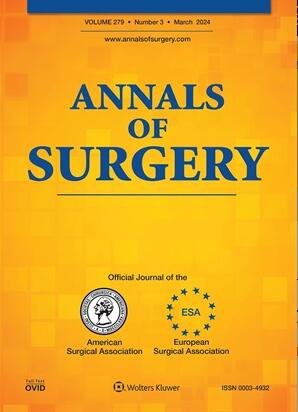高风险上消化道肿瘤切除术患者癌症特异性手术风险分层的新预测模型。
IF 6.4
1区 医学
Q1 SURGERY
引用次数: 0
摘要
目的:高危肿瘤切除术是上消化道实体瘤的主要治疗手段;然而,目前还没有针对这些手术的癌症特异性风险分层模型。方法我们研究了纪念斯隆凯特琳癌症中心(Memorial Sloan Kettering Cancer Center, 2015-2022) 2823例接受上消化道肿瘤切除术的腺癌患者,包括胃切除术、食管切除术、远端胰腺切除术和胰十二指肠切除术。单变量分析评估了住院时间(LOS)和并发症的风险因素,多变量分析纳入了对单变量分析和手术类型有重要意义的协变量。采用多变量模型建立nomogram来预测手术并发症和LOS。采用判别法(并发症的c指数,LOS的Kendall’s Tau)和校准图评估模型性能,并通过1000次bootstrap重复进行内部验证,以获得平均性能指标和95%置信区间。结果中位LOS为7.0 (IQR:6.0,10.0),术后30天总并发症发生率为31%。多变量分析发现,年龄、ASA bbbb3、COPD、肾功能衰竭、手术时间是LOS升高的独立危险因素(OR b>, P<0.05)。新辅助化疗(NAC)和切口前抗生素可降低LOS (OR<1, P<0.05)。并发症nomogram C-index为0.66,LOS nomogram Kendall's Tau为0.39。手术类型、年龄、COPD和NAC史在图上对LOS具有最大的区别价值;手术类型、种族和BMI对30天手术并发症的影响最大。结论:我们的肿瘤特异性术前和术后病理图为高危胃肠道肿瘤切除术患者评估风险和治疗结果提供了重要工具。本文章由计算机程序翻译,如有差异,请以英文原文为准。
A Novel Predictive Model for Cancer-Specific Surgical Risk Stratification of Patients Undergoing High-Risk Upper Gastrointestinal Oncologic Resections.
OBJECTIVE
High-risk oncologic resections are the primary curative interventions for solid upper gastrointestinal (GI) tumors; however, there are no cancer-specific risk-stratification models available for these operations.
METHODS
We studied 2823 Memorial Sloan Kettering Cancer Center patients (2015-2022) undergoing upper GI oncologic resections including gastrectomy, esophagectomy, distal pancreatectomy, and pancreaticoduodenectomy for adenocarcinoma. Univariable analyses assessed risk factors for length of stay (LOS) and complications, with multivariable analyses incorporating covariates significant on univariable analysis and procedure type. Nomograms were built using multivariable models to predict surgical complications and LOS. Model performance was evaluated using discrimination (C-index for complications, Kendall's Tau for LOS) and calibration plots and was internally validated with 1000 bootstrap replicates to obtain average performance metrics and 95% confidence intervals.
RESULTS
The median LOS was 7.0 (IQR:6.0,10.0), and the overall 30-day postoperative complication rates were 31%. Multivariable analysis identified age, ASA>3, COPD, renal failure, and operation length as independent risk factors for increased LOS (OR>1, P<0.05). Neoadjuvant chemotherapy (NAC) and pre-incision antibiotics reduced LOS (OR<1, P<0.05). The complication nomogram demonstrated a C-index of 0.66, while the LOS nomogram showed a Kendall's Tau of 0.39. Procedure type, age, and history of COPD and NAC had the greatest discriminatory values for LOS on the nomograms; procedure type, race, and BMI had the greatest impact on 30-day surgical complications.
CONCLUSION
Our cancer-specific pre- and postoperative nomograms for LOS and postoperative complications provide an important tool to appropriately estimate risks and treatment outcomes for patients undergoing high-risk GI oncologic resections.
求助全文
通过发布文献求助,成功后即可免费获取论文全文。
去求助
来源期刊

Annals of surgery
医学-外科
CiteScore
14.40
自引率
4.40%
发文量
687
审稿时长
4 months
期刊介绍:
The Annals of Surgery is a renowned surgery journal, recognized globally for its extensive scholarly references. It serves as a valuable resource for the international medical community by disseminating knowledge regarding important developments in surgical science and practice. Surgeons regularly turn to the Annals of Surgery to stay updated on innovative practices and techniques. The journal also offers special editorial features such as "Advances in Surgical Technique," offering timely coverage of ongoing clinical issues. Additionally, the journal publishes monthly review articles that address the latest concerns in surgical practice.
 求助内容:
求助内容: 应助结果提醒方式:
应助结果提醒方式:


